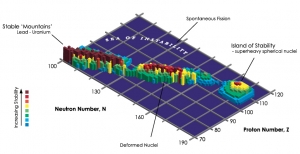Superheavy nuclei: between land and island
12-10-2022
The synthesis of super-heavy elements takes place as a result of heavy ion collisions. The resulting super-heavy nucleus can be both strongly excited (hot) and slightly excited (cold). Until now, there were no examples showing that both nuclear reaction scenarios could lead to the same terminal nuclei. The work of an international team of scientists with the participation of Polish physicists, published in September, shows that such a situation is possible.
„We showed for the first time how to reconcile two so far separate scenarios leading to the production of new super heavy elements” – says Professor Michał Kowal from the NCBJ Department of Theoretical Physics. „We determined the cross-section, i.e. the probability of performing hot synthesis with emission of several neutrons for the nucleus of the 277Cn element copernicus. Such a nucleus Was also produced by cold synthesis already 20 years ago in the GSI laboratory in Darmstadt (Germany). Our calculations show that the cross-section for the production of such a nucleus by the alternative hot fusion route is similar to that already measured for cold fusion.”
For years, researchers of super-heavy nuclei have also been intrigued by the so-called island of stability on the isotope map. When we place the known isotopes on the plane of the number of neutrons in the nucleus (horizontal axis) and protons (vertical axis), they will be arranged slightly below the diagonal, as there are usually more neutrons in the heaviest nuclei. Stable isotopes are only the central band of the „land” formed, and most of its surface is made up of known radioactive isotopes. This land – which is constantly being discovered – currently ends at 162 neutrons and 112 protons. Then there is a slight pause and there are other already known nuclides that form the so-called „Island of stability” (although the name can be misleading as the isotopes of this island only live for fractions of a second). Both the land and the island reflect our current experimental capabilities. By creating experimental systems that select the parameters of collisions more and more precisely and by building detectors capable of registering isotopes that live shorter and shorter lives, physicists are increasing the areas of the island and land. As a result, it leads to the fact that these areas are practically touching at the moment. However, these areas still differ in the nuclide production mechanisms. The 277Cn nucleus, as predicted by the authors, can be produced in both the hot and cold synthesis scenario. The nuclides from the island were made experimentally by hot synthesis. The extreme land nuclides are the result of cold synthesis (this is how 277Cn Was produced). Showing that border nuclei can be produced in various ways is a very interesting observation that helps to understand the nucleon binding mechanism in nuclei and the processes of their decay.
Theoretical calculations help in searching for nuclei lying on the border between land and island. They indicate how the most promising experiments should be prepared. A great help for researchers in this area of physics are tables of many basic nuclear properties, including nuclear masses and fission barriers, published a year ago by Polish physicists: Piotr Jachimowicz, PhD. from the University of Zielona Góra and Professors Michał Kowal and Janusz Skalski from NCBJ. Based on these results, and using the fusion model developed by professors Adamian and Antonenko from Dubna, the same international team examined further nuclei located on the border of the two areas. The most interesting of them is Darmstadt 280.
„We have observed that the fission barrier that keeps the system from disintegrating in this decay is the critical parameter for creating the boundary between land and island” explains Professor Kowal. „On land and on the island, these barriers counteract fission, and the excess energy of the excited nuclear system resulting from the collision of the missile and the target is removed by the emission of one, two or more neutrons. However, in the border area, these barriers are extremely low, and there no neutron has the slightest chance of winning the competition with the fission process.”
Investigating the scenarios of creating super-heavy elements is of great importance from the point of view of the experiments being prepared. Scientists’ calculations indicate that for readily available projectile-target combinations, the active cross-section for the hot fusion reaction, although still small, is within the range available for modern modernized missile accelerators for collision and detectors observing the reaction products.
Original works:
Hot and cold fusion reactions leading to the same superheavy evaporation residue, Hong, J. et al.; European Physical Journal A, 2022, 58 (9), 180;DOI 10.1140 / epja / s10050-022-00826-3
Isthmus connecting mainland and island of stability of superheavy nuclei,Hong, J. et al.; Physical Review C, 2022, 106 (1), 014614;DOI 10.1103 / PhysRevC. 106.014614





